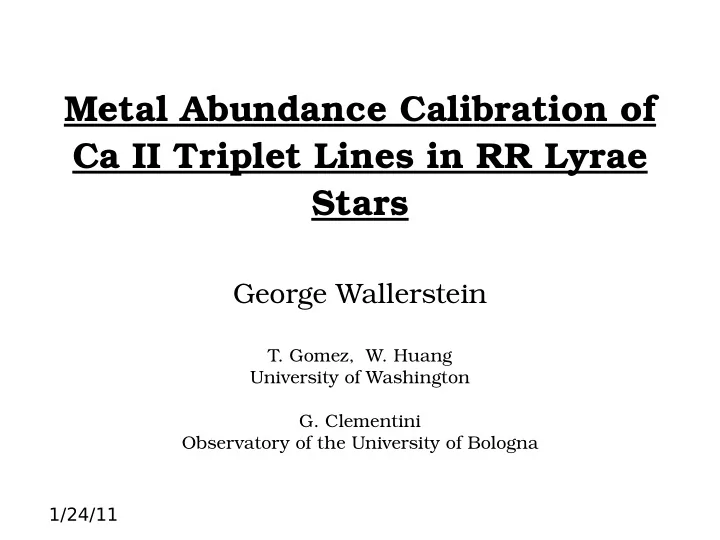

Metal Abundance Calibration of Ca II Triplet Lines in RR Lyrae Stars George Wallerstein T. Gomez, W. Huang University of Washington G. Clementini Observatory of the University of Bologna 1/24/11
Metallicity Metallicity was first discussed by Baade in the 1950’s regarding stellar populations Chamberlain & Allen showed that there were stars had metallicity 1/100 of the sun Birth of study of metal-poor stars 1/24/11
RR Lyrae Associated with Globular Clusters and the halo Considered population II stars Enter George Preston 1/24/11
1/24/11
A Spectroscopic Study of the RR Lyrae Stars 1/24/11
A Coarse Analysis of Three RR Lyrae Stars 1/24/11
Skip 50 years…. 1/24/11
Hipparcos π to +/- 0.001” Factor of 2 improvement (Van Leeuwen 2007) Re-Reduction: π to +/- 0.0005” 1/24/11
GAIA Factor of 10 improvement over Hipparcos + radial velocities π to +/- 20 μas (0.00002”) at 15th mag π to +/- 200 μas (0.0002”) at 20th mag Out to 10 kpc Likely 10’s of thousands of RR Lyrae Multiple spectrophotometric measurements down to 20th magnitude 1/24/11
GAIA spectra Will measure spectra to get radial velocities. Will measure each star 40 times on average Spectra window includes Hydrogen Paschen series an the Ca II triplet Measure spectra at 16.5 mag with S/N of 20 (for RR Lyrae, that’s out to 16 kpc) 1/24/11
APO Spectra Spectral Range is from 8470Å to 8750Å at a resolution of 11,500. Several RR Lyrae stars, showing various temperatures and [Fe/H] values. 1/24/11
High Res/Low Res ng a Gaussian fitting program. Measuring the Ca II triplet is pretty consistent, with few excep d between low and high resolution due to where the continuum is defined. 1/24/11
Determining Temperature As with Balmer lines, the temperature of the star can be roughly determined by measuring the EW of the Paschen line at 8598Å. 1/24/11
Calculating [Fe/H] Derived [Fe/H] from new MOOG values using Fe II Did not use Fe I due to departures from LTE Observations at random phases to simulate GAIA 1/24/11
ΔS Calibration Δ S was used to calibrate [Fe/H] by Preston and Layden Clementini showed correlation between EW of Ca II K and [Fe/H] 1/24/11
Calibrating [Fe/H] There is an (approximately) linear relationship between the Ca II EW and [Fe/H] EW does not vary with phase by more than 10 % 1/24/11
References Clementini, G., Tosi, M. and Merighi, R 1991, AJ 101, 2168 Cole, A.A, Smecker-Hane, T.A., Tolstoy, E., Bosler, T.L., and Gallagher, J.S., Mon. Not. R. 2004 Astron. Soc. 347, 367 Feast, M.W., Laney, C.D., Kinman, T.D., Van Leeuwen, F ., Whitelock, P .A. 2008 Mon. Not. R. Astron. Soc., 386, 2115 Layden A., 1994 AJ 108, 3 Preston, G.W. 1959 AJ 130, 507 1/24/11
Recommend
More recommend